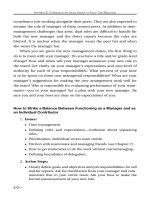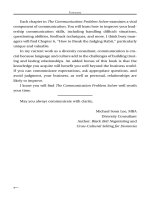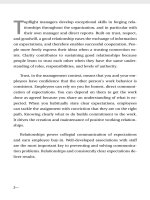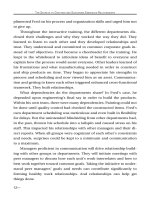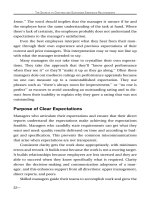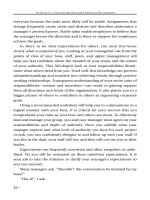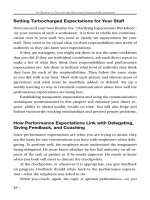The Communication Problem Solver 12 pptx
Bạn đang xem bản rút gọn của tài liệu. Xem và tải ngay bản đầy đủ của tài liệu tại đây (82.29 KB, 10 trang )
H
OW TO
U
SE
Y
OUR
P
ROCESS
S
KILLS TO
P
REVENT AND
S
OLVE
C
OMMUNICATION
P
ROBLEMS
Did you complete the monthly report?
Did you give the customer the handout on our service policy?
By what percentage did our market share grow last year?
Do you work at home on Fridays?
Does our competitor sell this product?
Could we meet on Monday?
Could we come up with three options by Thursday?
Can your team meet the deadline if we add this new task?
Should we give gift certificates as a performance reward?
Are you CPR certified? When does your certification expire?
Are you ready to give your presentation to the executive committee?
Are we within budget?
Were you in our Paris office last week?
What is the budget for this project?
What is the address of the New York office?
What department do you work in?
3. Behavioral Questions
Behavioral questions use past behavior to predict what a person might
do in the future. Behavior is what a person does or says. It is the observ-
able manner in which a person acts or performs under specified circum-
stances. Behavioral questions refer to actions others can observe by
using the five senses. In most offices, actions you can actually see people
doing or statements you can hear them saying can be described as be-
havior. In libraries, stores, labs, manufacturing plants, restaurants, and
other environments you may be able to apply the other senses of touch,
smell, and taste.
When to Use.
Most often behavioral questions are used in interviewing
to discover what applicants have accomplished in the past and the way
92—
T
OP
-T
IER
Q
UESTIONING
T
ECHNIQUES
they did it. The idea is to project how the candidate would handle a
similar situation on the job the manager has open. Some of my clients
have also used behavioral questions in team training meetings. The
manager asks teammates to answer a behavioral question about how
they have handled a challenge. Several coworkers might answer the
same question. As the colleagues listen, they learn a variety of ways to
handle similar situations. Behavioral questions can also be used in
coaching sessions to help employees build off a foundation of their past
successes.
Benefits to Manager.
Allows manager to zero in on specific work sce-
narios and target how a person has dealt with them in the past.
Downside.
Their use is limited primarily to interviewing, unless the
manager creatively finds ways to use them in progress discussions, train-
ing, and coaching.
How to Formulate.
There are three elements of a behavioral question:
The manager asks the question in the past tense and then asks the candi-
date to give a specific situation or example and tell exactly how he han-
dled the situation.
Examples of Behavioral Questions
Describe a difficult problem you had with a customer and how you
handled it. (As opposed to open questions, such as ‘‘Are you good
with customers?’’ Or ‘‘Tell me about your customer service prob-
lems.’’)
Tell me about a specific time when you had to deal with a gray area
because there were no policies and procedures to follow. How did
you handle it? (As opposed to ‘‘How well do you work when there
are no established policies and procedures?’’)
What was the last dangerous situation you faced on the job and how
did you resolve it? ( As opposed to ‘‘How safely do you work?’’)
Tell me about a typical day when there were a moderate number of
interruptions and how you handled the situation and balanced the
—93
H
OW TO
U
SE
Y
OUR
P
ROCESS
S
KILLS TO
P
REVENT AND
S
OLVE
C
OMMUNICATION
P
ROBLEMS
work. ( As opposed to ‘‘How closely do you concentrate when there
are interruptions?’’)
Describe what specifically you did as a team leader that made you
excel. Please give a specific example. ( As opposed to ‘‘What are
your strengths as a team leader?’’)
Please give me an example of a time on a project when you thought
you might go over budget and how you resolved it. ( As opposed to
‘‘How do you handle project budgets?’’)
Examples for Monitoring Progress and/or Coaching
Tell me about your greatest achievement this past quarter and how you
accomplished it.
Describe exactly what process you followed that enabled you to exceed
quota this month. How did you go about it?
Tell me about your biggest organizational challenge on the project so
far and how you handled it.
What was last month’s most important scheduling issue, and how did
you resolve it?
Describe specifically what your department has done this quarter to
contribute to the XXX corporate initiative in light of the budget cuts
and how you went about it.
4. Situational Questions
Situational questions invite a person to think about how they would han-
dle a situation that might arise in the future. These are ‘‘if/then’’ ques-
tions. They are designed to ask what a person would do, given a specific
situation. They are hypothetical in nature and always asked in the fu-
ture—‘‘Suppose X happened. What would you do?’’
When to Use.
Use situational questions during interviewing, delegating,
feedback, coaching, training, role-playing, rehearsing, or preparing for
tough situations that might occur. You can use situational questions to
do a practical run-through of potential problems and opportunities.
94—
T
OP
-T
IER
Q
UESTIONING
T
ECHNIQUES
Benefits to Manager.
They are useful when interviewing senior execu-
tive candidates and others to learn about their creative and spontaneous
problem-solving and decision-making skills. On the job, such questions
help a manager understand how a direct report would handle a situation
of concern to the manager. They serve as a jumping-off point for discus-
sion on alternative approaches to the work. They are a great coaching
tool. Such questions help people think through how to solve their own
problems and make their own decisions. They let employees know you
trust their capability to handle situations. They reinforce your expecta-
tions that the employees plan and practice in advance and that you are
there to help. Situational questions emphasize that you need to be kept
in the loop, although employees are the owners of the situation.
Downside.
You have to be sure to get agreement that the employee’s
statement of how she would handle the situation is in fact going to be
the approach she will follow.
How to Formulate.
The questioner provides the specific scenario, as
opposed to behavioral questions, which request the person answering
the question to provide the example. It asks how a person thinks they
would handle it in the future, not how they’ve done it in the past.
Examples of Situational Questions
Since you have not handled national accounts before, how would you
handle X difficulty with a nationwide customer?
Let’s say the CEO asks you ‘‘X’’ in your upcoming presentation. How
would you answer?
If you were to sell the new software to our top account, how would you
handle the technical aspects?
If you were asked to increase productivity by 10 percent on your team,
what would you do?
If you had to cut your budget by 6 percent, how would you handle it?
As head of HR, how would you plan and manage a downsizing if we
have to go that route?
—95
H
OW TO
U
SE
Y
OUR
P
ROCESS
S
KILLS TO
P
REVENT AND
S
OLVE
C
OMMUNICATION
P
ROBLEMS
As marketing director, how would you handle the advertising of our
new product if our customer base diversifies and grows by 25 per-
cent?
If the other department has a conflicting priority with your project,
how would you resolve it?
If your staff told you there is a quality problem with the new product
due out this month, what would you do?
Using Questions for Problem-Solving and Decision-
Making Processes
Chapter 4 discussed process as a formal, step-by-step approach to work.
Successful organizations have processes, or systematic approaches, to
manufacturing, sales, engineering, quality control, and so on.
Management activities can also benefit from having a systematic ap-
proach. For example, every day managers solve problems and make de-
cisions. What can managers learn from engineers who analyze problems
to find the root cause? Engineers might look for the exact reason a com-
ponent failed or why there were variations in production instead of all
products meeting the expected standard. They typically have a standard
approach to finding root causes of problems. Part of this step-by-step,
precise process is asking questions to ferret out accurate data.
Every day managers solve problems using analytical skills. They ask
themselves questions in order to find the root cause of a problem before
making a decision on what to do about it. The problems can relate to
any function of the business within the manager’s span of control.
Maybe there is a problem that a marketing campaign did not succeed
and the team needs to know why. Or maybe a project is over budget and
the manager needs to find the cause.
Some of the process questions often used to find root causes of prob-
lems are included here:
What is the exact problem to be solved?
How do I know?
96—
T
OP
-T
IER
Q
UESTIONING
T
ECHNIQUES
Who else can shed light on this?
Why ask those particular people?
When did the problem first occur?
Why didn’t it occur earlier?
What else was going on at that time? What changed?
Is the trend getting worse, getting better, or staying the same?
How big or small is the problem?
What is the impact on the rest of the task/project/machine/team?
How does it change our time frame?
Who else needs to be notified?
What exactly is wrong?
Is the pattern of the problem intermittent, or constant?
Are other projects/tasks/machines/teams experiencing the same prob-
lem?
Why or why not?
What are the differences and similarities between our projects/tasks/
machines/teams and theirs?
What are some potential causes of the problem?
How does each of those possible reasons fit with the observed facts?
Just as for find ing the cau se of a work pro blem, an an alyt ical decision-
making process also requires questions. Questions can help the manager
uncover information to make an informed decision on something as rel-
atively straightforward as ‘‘What desks should we purchase?’’ to more
complex, intricate decisions, such as ‘‘Where in Asia should we locate
our factory?’’
Some typical decision-making process questions are included here:
What is the decision to be made?
Why is it being made?
What is the need for the decision?
Who should help make this decision?
At which point in the decision-making process should each person be
brought in?
—97
H
OW TO
U
SE
Y
OUR
P
ROCESS
S
KILLS TO
P
REVENT AND
S
OLVE
C
OMMUNICATION
P
ROBLEMS
What are the criteria?
Which criteria are ‘‘essential’’ and must absolutely be met (budget,
timelines, specifications)?
Which criteria would enhance the solution and are ‘‘nice to have,’’ but
are not required?
What are the alternative solutions?
How does each alternative compare to the list of criteria?
Which alternatives are eliminated because they don’t meet all ‘‘essen-
tial’’ criteria?
If an alternative meets all the ‘‘essential’’ criteria, how well does it meet
the specified ‘‘nice to have’’ criteria?
What are the risks associated with choosing each alternative?
How well can the team manage each of those risks to prevent potential
problems?
How serious would it be if a problem occurred despite our best preven-
tion efforts?
How can problems be resolved it they do occur?
How can the team best leverage possible opportunities?
What is the best decision?
Determining the best questions to ask to solve work-related prob-
lems and make decisions will be your call based on your situation. The
important point is for you to collect an array of questions and become
an expert using them at appropriate times.
Using Questions to Prevent and Solve People Problems
When managers use expert questioning techniques in delegating, moni-
toring work progress, giving feedback, and coaching they will prevent
problems with people. However, despite best efforts, misunderstandings
and conflicts will occur. Managers can be most effective if they use ques-
tions to prevent and solve people problems. Managers should remain
neutral and ask questions to find root causes of the problem, just like
they would do if there were a variation in performance of a machine or
98—
T
OP
-T
IER
Q
UESTIONING
T
ECHNIQUES
functional work situation. If managers identify the source of the prob-
lem, and use it as a learning opportunity, they are positioned for a more
lasting solution that also preserves the relationship.
The list of questions to ask when problem solving or making deci-
sions for functional work issues (covered in the section on using ques-
tions for problem solving and decision making) can be applied to
situations involving people too. If a person did not meet a deadline, it is
more useful to find out why than to label the person a ‘‘poor performer.’’
A manager can more easily solve the problem by staying with the issue at
hand and the observable facts when evaluating performance and giving
feedback. At a checkpoint meeting, if the milestone was missed, an
opening question (asked in a friendly, supportive tone of voice) might
be ‘‘What happened?’’ or ‘‘What’s going on?’’ These open-ended ques-
tions do not assess blame, so they help the employee save face. The
employee can then open up and answer the question in a number of
different ways. You might find out there is an organizational obstacle, a
supplier didn’t meet the agreed-upon timelines, or another department
did not deliver when it had agreed. A new opportunity might have
evolved. If the delay is the employee’s responsibility, you might learn
about a skill or motivational concern. In any case, you are better pre-
pared to ask more questions.
Often at this point, a manager will say, ‘‘What can I do to help?’’
which moves right to a solution. If an employee is ‘‘stuck,’’ it might be
more useful to coach with process questions so the employee can solve
his own problem. These questions aid employees in discovering more
about the problem and enable them to develop their own process skills.
For problem solving or decision making, you can ask open-ended
questions from the list in that section of this chapter. Other questions to
help the employees tap their own resources might be:
What parts of the project are working well? Why? How could you use
that as a basis for the part you are working on now?
—99
H
OW TO
U
SE
Y
OUR
P
ROCESS
S
KILLS TO
P
REVENT AND
S
OLVE
C
OMMUNICATION
P
ROBLEMS
What tasks have been successful? What did you do that made them
work? What could you apply from what you did in the past to the
task at hand?
What are the obstacles to meeting this goal? What have you done to
remove similar obstacles in the past? What needs to be done to
remove the present impediments?
What else do you need? How best to get that?
Who else is/what other groups are impacted? What is the best way to
work with them on this? What trade-offs need to be made?
What are the alternatives? What other choices are there? How do they
compare with the criteria we need met?
What support do you need from whom? What is the best way to get the
support or resource? What do you need to do to support someone
else?
What do you need to do differently? What do you need to change? How
can you improve the situation? When will you do that?
Given all we’ve talked about, what is your current plan of action? How
will you keep me informed?
What questions do you have?
Summary
Expertise in asking questions leads to more organized, collegial, and pro-
ductive conversations when delegating, monitoring progress, giving
feedback, and coaching. The more adept the manager is at using ques-
tions in these management processes, the more each direct report will
be working to his or her potential and contributing to team develop-
ment.
Planning ahead and developing effective questions can boost your
confidence as well as your competence. Prepared questions can help you
analyze and evaluate situations factually and follow logical steps. Asking
questions also draws in the direct report’s opinions and expertise and
thus enhances the working relationship. Asking well-framed questions
advances your direct report’s competency and confidence and thus pre-
vents people problems while increasing collaboration.
In Chapter 6, we address how to unravel judgments when people
problems do occur in spite of a manager’s best efforts at prevention.
100—
CHAPTER
6
How to Break the Judging Habit
This chapter tackles the cause of many communication problems: judg-
ing, sometimes called labeling. This common habit is when people form
an opinion of someone and put a label on that person, such as ‘‘slacker’’
or ‘‘know-it-all’’ or ‘‘lazy.’’ This kind of judging has a negative impact on
management communication because it prevents problem solving and
can actually produce greater problems. Judging stops a manager’s ratio-
nal discovery process and creates tension within relationships. This
chapter discusses many of the most frequent examples of judging/label-
ing and shows a process for how to turn these opinions into facts with
solutions. When managers substitute the process described in this chap-
ter for judging, they improve communication and dissolve bad feelings
that deter achieving results. Managers who develop the process skill of-
fered in this chapter also expand their ability to prevent people prob-
lems.
What Is Judging?
Judging is defined here as categorizing a person by labeling, or describ-
ing him or her with a word or term. Characterizing people with a name,
or label, classifies them into vague groups, such as ‘‘the lazy people.’’
People may or may not agree on what ‘‘lazy’’ means, but one thing is for
sure—a manager cannot fix ‘‘lazy.’’ Sometimes judging is referred to as
‘‘name calling’’ or ‘‘tagging’’ or ‘‘giving a negative descriptor.’’
—101


